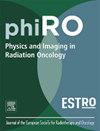Temporal drift in calibration of Ir-192 brachytherapy sources: A multi-center study on dosimetric discrepancies and metrological consistency
IF 3.3
Q2 ONCOLOGY
引用次数: 0
Abstract
Background and purpose
High-dose-rate (HDR) brachytherapy relies on accurate and metrologically traceable source strength determination. Recent anecdotal reports and preliminary studies have suggested a possible temporal drift in the reference air kerma rate (RAKR) measured by clinical users compared to manufacturer certificates for 192Ir sources. This study investigates the existence and magnitude of such drift across a large, multicenter European dataset and explores potential underlying causes.
Materials and methods
A total of over 1700 RAKR measurements for HDR and PDR brachytherapy sources, collected over two decades from 29 centers in 10 European countries, were analyzed. The ratio of hospital-measured RAKR to manufacturer-certified RAKR was assessed using linear regression and t-tests to evaluate drift. Data were corrected for center-dependent systematics and segmented around key dates corresponding to changes in primary standards. Supplementary analyses included leave-one-out testing and time-segmented trend assessment.
Results
A statistically significant drift (+0.15 %/year) was detected for all 192Ir source types after 2018, correlating temporally with updates in the German Physikalisch-Technische Bundesanstalt (PTB) primary standards laboratory. Removing PTB corrections from manufacturer values nearly eliminated the observed drift. No such trend was observed for 60Co sources.
Conclusion
The findings reveal a drift in hospital-to-manufacturer Ir-192 RAKR ratios that is temporally correlated with changes in metrology standards, not uniformly implemented across calibration chains. The true cause is however still unknown. The study aimed to investigate that greater transparency and harmonization among all stakeholders are essential to ensure dosimetric accuracy in HDR brachytherapy.
校正Ir-192近距离治疗源的时间漂移:剂量学差异和计量一致性的多中心研究
背景和目的高剂量率(HDR)近距离放射治疗依赖于精确和计量可追溯的辐射源强度测定。最近的轶事报道和初步研究表明,临床用户测量的参考空气克尔曼率(RAKR)与制造商认证的192Ir源相比可能存在时间漂移。本研究通过一个大型、多中心的欧洲数据集调查了这种漂移的存在和程度,并探讨了潜在的潜在原因。材料和方法对欧洲10个国家29个中心20多年来收集的HDR和PDR近距离治疗源的1700多个RAKR测量结果进行了分析。医院测量的RAKR与制造商认证的RAKR的比值采用线性回归和t检验来评估漂移。根据中心相关的系统分类对数据进行了校正,并根据主要标准的变化对关键日期进行了分割。补充分析包括留一检验和时间分段趋势评估。结果2018年后,所有192Ir源类型均检测到统计学上显著的漂移(+ 0.15% /年),这与德国物理技术联邦(PTB)一级标准实验室的更新时间相关。从制造商的值中去除PTB修正几乎消除了观察到的漂移。60个co源没有观察到这种趋势。结论:研究结果表明,医院与制造商之间Ir-192 RAKR比率的漂移与计量标准的变化有时间相关性,而不是在校准链中统一实施。然而,真正的原因尚不清楚。该研究旨在调查所有利益相关者之间更大的透明度和协调对于确保HDR近距离治疗剂量学准确性至关重要。
本文章由计算机程序翻译,如有差异,请以英文原文为准。
求助全文
约1分钟内获得全文
求助全文
来源期刊

Physics and Imaging in Radiation Oncology
Physics and Astronomy-Radiation
CiteScore
5.30
自引率
18.90%
发文量
93
审稿时长
6 weeks
 求助内容:
求助内容: 应助结果提醒方式:
应助结果提醒方式:


